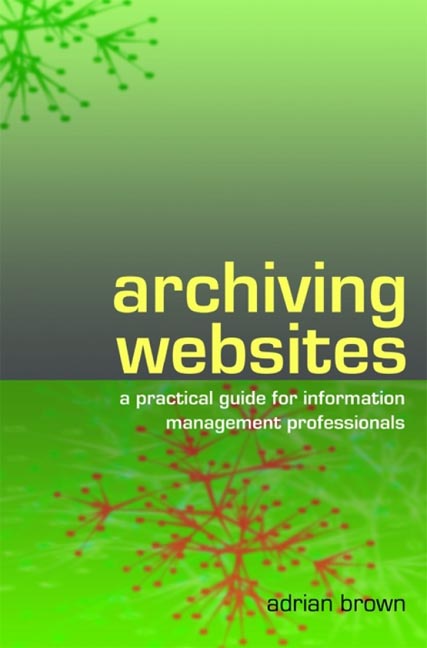Book contents
- Frontmatter
- Contents
- Acknowledgements
- Glossary
- 1 Introduction
- 2 The development of web archiving
- 3 Selection
- 4 Collection methods
- 5 Quality assurance and cataloguing
- 6 Preservation
- 7 Delivery to users
- 8 Legal issues
- 9 Managing a web archiving programme
- 10 Future trends
- Appendix 1 Web archiving and preservation tools
- Appendix 2 Model permissions form
- Appendix 3 Model test script
- Appendix 4 Model issues log
- Appendix 5 Model job description
- Bibliography
- Index
- Digital Preservation
9 - Managing a web archiving programme
Published online by Cambridge University Press: 08 June 2018
- Frontmatter
- Contents
- Acknowledgements
- Glossary
- 1 Introduction
- 2 The development of web archiving
- 3 Selection
- 4 Collection methods
- 5 Quality assurance and cataloguing
- 6 Preservation
- 7 Delivery to users
- 8 Legal issues
- 9 Managing a web archiving programme
- 10 Future trends
- Appendix 1 Web archiving and preservation tools
- Appendix 2 Model permissions form
- Appendix 3 Model test script
- Appendix 4 Model issues log
- Appendix 5 Model job description
- Bibliography
- Index
- Digital Preservation
Summary
Introduction
This chapter describes the practicalities of establishing, resourcing and maintaining a web archiving programme. It discusses the variety of operational models available, the relative merits and disadvantages of each, and the factors that might influence the selection of the most appropriate strategy. It examines management issues and identifies the range of staff skills required. It concludes with a case study provided by the web archiving programme developed by The National Archives of the UK (TNA), which offers a practical example of how one such a programme was established and developed in recent years.
Alternative operational models
A number of different models have emerged for developing and implementing a web archiving programme. These can be broadly categorized as follows:
• in-house: programmes are entirely resourced, managed and implemented within the organization
• contracted-out: programmes have all or some aspects of the work performed by a contractor
• consortia: programmes are implemented by a consortium of organizations, using some degree of shared infrastructure.
Each of these models is discussed in detail below. Every approach has specific advantages and disadvantages and, in practice, many organizations choose to implement programmes that include elements from more than one model.
The in-house model
A web archiving programme which is implemented and operated entirely using in-house resources does, in principle, offer the greatest flexibility and control. However, it also places the entire burden of risk on the organization, and the complexities involved mean that this is not an option to be undertaken lightly.
Clearly, this option is only viable if the necessary skills, infrastructure and other resources for each stage of the programme are either already available in-house, or can be realistically developed. As such, in-house programmes tend to be the province either of very large organizations, or of those with very small-scale programmes.
The contracted-out model
An organization may not wish to invest in establishing all of the infrastructure and other resources required to undertake web archiving in-house. In this case, contracting out some or all elements of the programme may be an attractive option. It may be possible to use a contractor with existing experience in the field, but there is a limited pool available and it is equally possible to use a contractor with transferable skills.
- Type
- Chapter
- Information
- Archiving Websitesa practical guide for information management professionals, pp. 163 - 183Publisher: FacetPrint publication year: 2006



